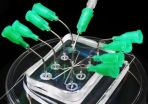(Press-News.org) Lab on a chip (LOC) devices—microchip-size systems that can prepare and analyze tiny fluid samples with volumes ranging from a few microliters (millionth of a liter) to sub-nanoliters (less than a billionth of a liter)—are envisioned to one day revolutionize how laboratory tasks such as diagnosing diseases and investigating forensic evidence are performed. However, a recent paper* from the National Institute of Standards and Technology (NIST) argues that before LOC technology can be fully commercialized, testing standards need to be developed and implemented.
"A testing standard," explains NIST physical scientist and paper author Samuel Stavis, "defines the procedures used to determine if a lab on a chip device, and the materials from which it is made, conform to specifications." Standardized testing and measurement methods, Stavis writes, will enable MEMS (microelectromechanical systems) LOC manufacturers at all stages of production—from processing of raw materials to final rollout of products—to accurately determine important physical characteristics of LOC devices such as dimensions, electrical surface properties, and fluid flow rates and temperatures.
To make his case for testing standards, Stavis focuses on autofluorescence, the background fluorescent glow of an LOC device that can interfere with the analysis of a sample. Stavis states that multiple factors must be considered in the development of a testing standard for autofluorescence, including: the materials used in the device, the measurement methods used to test the device and how the measurements are interpreted. "All of these factors must be rigorously controlled for, or appropriately excluded from, a meaningful measurement of autofluorescence," Stavis writes.
Quality control during LOC device manufacturing, Stavis says, may require different tests of autofluorescence throughout the process. "There may be one measure of autofluorescence from the block of plastic that is the base material for a chip, another once the block has been fashioned into the substrate in which the functional components are embedded, and yet another as the final device is completed," Stavis says. "To manufacture lab on a chip devices with reliably low autofluorescence, accurate measurements may be needed at each stage."
Stavis also emphasizes that it is important not to confuse testing standards with product standards, and to understand how the former facilitates the latter. "A product standard specifies the technical requirements for a lab on a chip device to be rated as top quality," he says. "A testing standard is needed to measure those specifications, as well as to make fair comparisons between competing products."
INFORMATION:
* Stavis, S.M. A glowing future for lab on a chip testing standards. Lab on a Chip (2012), DOI: 10.1039/c2lc40511c
NIST focuses on testing standards to support lab on a chip commercialization
2012-08-09
ELSE PRESS RELEASES FROM THIS DATE:
Depression linked with increased risk of peripheral artery disease
2012-08-09
Depression was linked with an increased risk of peripheral artery disease (PAD) in a study of more than one thousand men and women with heart disease conducted by researchers at the San Francisco VA Medical Center and the University of California, San Francisco.
PAD is a circulatory problem in which narrowed arteries reduce blood flow to the limbs – usually the legs and feet – resulting in pain, reduced mobility and, in extreme cases, gangrene and amputation.
The study was published electronically on July 26, 2012, in the Journal of the American Heart Association.
Marlene ...
Scientists use worms to unearth cancer drug targets
2012-08-09
BETHESDA, MD – August 9, 2012 -- Through novel experiments involving small nematode worms, scientists from Wyoming have discovered several genes that may be potential targets for drug development in the ongoing war against cancer. Specifically, researchers hypothesize that inhibiting these genes could reverse certain key traits associated with cancer cells. This discovery is published in the August 2012 issue of the Genetics Society of America's journal GENETICS (www.genetics.org).
"Cancer is a leading cause of death worldwide," said David S. Fay, Ph.D., a researcher ...
New Genetics educational resource promotes active learning
2012-08-09
BETHESDA, MD – August 9, 2012 -- As upper level undergraduate genetics instructors plan their syllabi for the fall semester, the Genetics Society of America's GENETICS journal offers a new educational resource, articles called "Primers." These articles are designed to bring cutting-edge scientific research into the classroom by making scientific papers accessible to students.
The principal learning goal of the Primer is to "make research and genetics accessible to a much broader audience, not just researchers, their postdocs and grad students, but also to undergraduates ...
Genetics Society of America’s GENETICS journal highlights for August 2012
2012-08-09
Bethesda, MD—August 9, 2012 – Listed below are the selected highlights for the August 2012 issue of the Genetics Society of America's journal, GENETICS. The August issue is available online at www.genetics.org/content/current. Please credit GENETICS, Vol. 191, AUGUST 2012, Copyright © 2012.
Please feel free to forward to colleagues who may be interested in these articles.
ISSUE HIGHLIGHTS
New negative feedback regulators of Egfr signaling in Drosophila, pp. 1213
Jonathan P. Butchar, Donna Cain, Sathiya N. Manivannan, Andrea D. McCue, Liana Bonanno, Sarah Halula, ...
Scientists discover how iron levels and a faulty gene cause bowel cancer
2012-08-09
HIGH LEVELS of iron could raise the risk of bowel cancer by switching on a key pathway in people with faults in a critical anti-cancer gene, according to a study published in Cell Reports* today (Thursday).
Cancer Research UK scientists, based at the University of Birmingham and the Beatson Institute for Cancer Research in Glasgow, found bowel cancers were two to three times more likely to develop in mice with a faulty APC gene that were fed high amounts of iron compared to mice who still had a working APC gene.
In contrast, mice with a faulty APC gene fed a diet low ...
Urban poor plagued by 'burdens of place'
2012-08-09
EAST LANSING, Mich. — Most of America's urban cores were designed for walking but offer little in the way of supermarkets, healthy restaurants and other amenities for residents to walk to, according to a study led by a Michigan State University scholar.
The study is one of the first to show that poor residents living in declining urban neighborhoods want healthy food choices – evidenced by their willingness to travel long distances to find them. Past research has generally assumed that poor people will shop at whatever store is closest.
But compared with suburban residents, ...
Plenty of dark matter near the Sun
2012-08-09
Dark matter was first proposed by the Swiss astronomer Fritz Zwicky in the 1930s. He found that clusters of galaxies were filled with a mysterious dark matter that kept them from flying apart. At nearly the same time, Jan Oort in the Netherlands discovered that the density of matter near the Sun was nearly twice what could be explained by the presence of stars and gas alone. In the intervening decades, astronomers developed a theory of dark matter and structure formation that explains the properties of clusters and galaxies in the Universe, but the amount of dark matter ...
Looking to Lose Weight?
2012-08-09
SHREWSBURY, MA – A new study published in Nutrition Journal shows that people can lose weight while consuming typical amounts of sugar or high fructose corn syrup (HFCS) if their overall caloric intake is reduced.
"Our research debunks the vilification of high fructose corn syrup in the diet," said James M. Rippe, M.D., one of the study authors. "The results show that equally reduced-calorie diets caused similar weight loss regardless of the type or amount of added sugars. This lends further support to findings by our research group and others that table sugar and HFCS ...
89 million people medically uninsured during 2004 to 2007
2012-08-09
Eighty-nine million Americans were without health insurance for at least one month during the period from 2004 to 2007, and 23 million lost coverage more than once during that time, according to researchers at Penn State and Harvard University.
"These findings call attention to the continuing instability and insecurity of health insurance in our country," said Pamela Farley Short, professor of health policy and administration, Penn State. "With more than a third of all Americans under age 65 being uninsured at some point in a four-year period, it's easy to see that the ...
He/she, him/her – a sign of women's place in society?
2012-08-09
Language use in books mirrors trends in gender equality over the generations in the US, according to a new study by Jean Twenge, from San Diego State University, and colleagues. Their work explores how the language in the full text of more than one million books reflects cultural change in U.S. women's status. The study is published online in Springer's journal Sex Roles.
Twenge and colleagues, W. Keith Campbell and Brittany Gentile of the University of Georgia, examined whether the use of gendered pronouns such as 'he' and 'she' mirrored women's status between 1900-2008, ...



